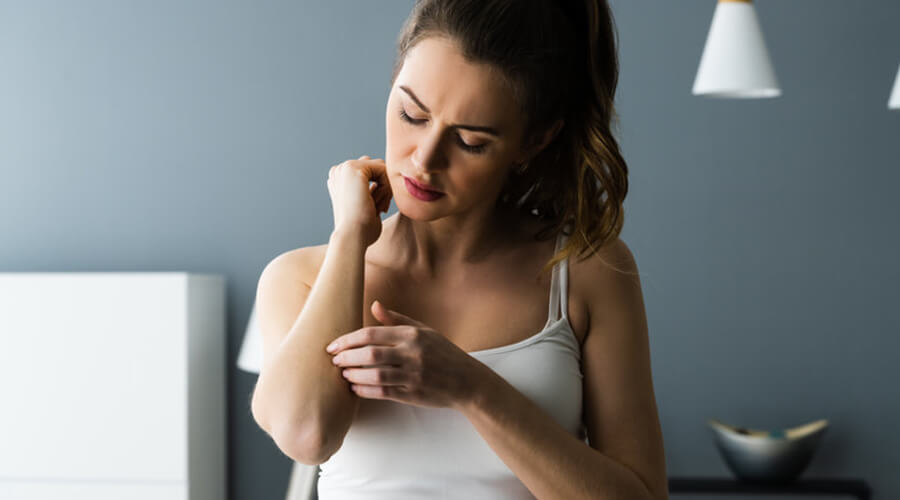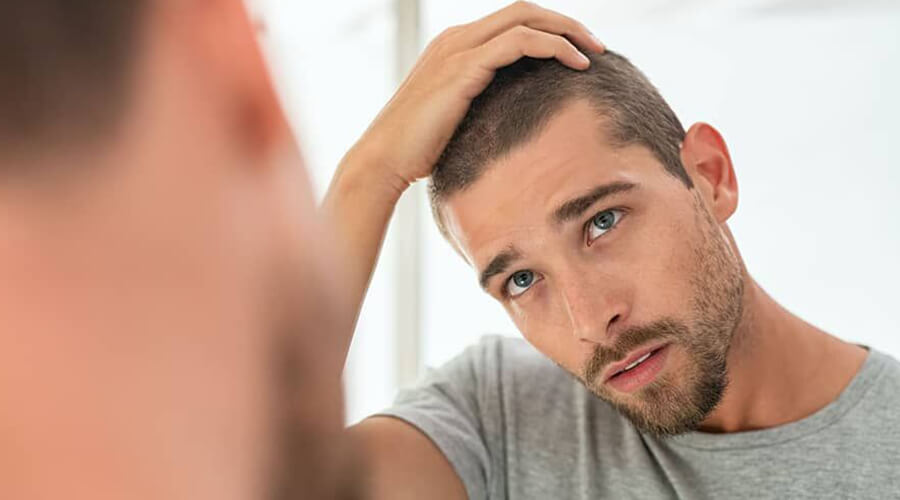
You’ve probably all heard of the skin condition psoriasis. Psoriasis is a non-contagious disease that unfortunately occurs quite often.
Psoriasis is a chronic and incurable disease. Psoriasis develops when the skin cells regenerate too quickly due to faulty signals from the immune system, in 3-4 days instead of the usual 28-30 days. Psoriasis has characteristic symptoms. Excess skin cells appear on the surface of the skin as red, scaly, flaky and inflamed rashes. These rashes may itch, bleed, break up and, of course, hurt. These rashes can cause serious lesions on the skin and unfortunately they can make you feel very unwell because you can be stared at on the street. People with psoriasis are often discriminated against. Psoriasis usually affects the limbs, genitals, joints and scalp, but it can affect any part of the body.
Psoriasis can also have a negative impact on the patient’s quality of life. Some research suggests that living with this problem may be worse than living with other chronic diseases. What was considered worse, according to the research, was depression. It can come in many forms. Doctors usually categorise it as mild, moderate or severe based on the amount of scaling, redness and the size of the affected area. The severity of psoriasis is measured in clinical trials. The classification system is called the Psoriasis Area and Severity Index (PASI). This system usually ranges from 0 to 72. The higher the score the more severe the conditio
Mild – 10 PASI value
Medium – 10-50 PASI value
Severe – 50-72 PASI value
Different forms of psoriasis affect roughly one in 50 people worldwide. It can develop at any age, even in infancy, but most commonly affects people aged 15-35. There are several distinct types of psoriasis and they not only differ in appearance but also require different treatments.

Let’s look at what these types are:
Patchy psoriasis (plaque): this develops in 75-80% of cases. It tends to be the most common form of psoriasis. This type is characterised by a scaly, silvery-white layer and a thickened red skin surface. It most commonly appears on the knees, scalp, elbows, behind the ears, navel, sacrum, genital area and buttocks.
Spotted psoriasis (guttate): this affects roughly 15-20% of psoriasis sufferers. This form is most common in children. Dropshaped, thin scales of varying diameter are formed. Most of them form on the trunk or face. It usually occurs after an infection.
Pustular psoriasis: affects 2% of cases. It is a rarer and more difficult to treat form of psoriasis. It tends to develop in older people. It appears as small blisters which are mainly visible on the hands and feet in red form. It is also called vesicular psoriasis because of its characteristic symptoms.
Eritrodermic psoriasis: occurs in 1-2% of cases. Inflammatory rashes appear on up to the entire body surface and are accompanied by reddening. It develops in people with chronic psoriasis and in people over 50 years of age.
Psoriasis of the scalp: 50% of cases. It is a plaque type of psoriasis and unfortunately quite difficult to treat due to the thickness of the plaques.
Inverse psoriasis: this type occurs only in the folds of the body, in the creases (armpits, groin, skin folds). The rashes are smooth and red but not scaly.
Psoriatic arthritis: 2-3% of patients suffer from this. It is a type of arthritis that causes inflammation and swelling of the hands, feet or joints. It can cause stiffness, pain and even joint damage. These inflammations are most commonly associated with psoriasis.
Nail psoriasis: can affect 50% of cases. Large and deep irregularly shaped holes appear on the nails. Most patients will have a lesion of the nails.
After the types of psoriasis, let’s now look at the signs that you may be suffering from psoriasis:
1. One of the most common signs of psoriasis is the appearance of a dark red, scaly nodule (or red rash) on the skin that protrudes slightly from the skin surface. The nodule can be as small as 1-2 cm in size and several of these can develop into a large plaque several cm in size. These plaques are distinct from the healthy skin surface and are usually covered with a kind of squamous cellular peeling that is waxy white in colour. This peeling layer can be scraped off very easily, and then small spots of tiny bleeding can be seen – this is called Auspitz symptoms. This occurs because the vascular structure of the skin in the plaques is completely altered.
2. Another sign of the disease is Köbner’s symptom, which means that psoriasis nodules develop after at least 2 weeks in response to stimuli to the skin. It usually develops in scars or around parts of the body after surgery. The Köbner phenomenon explains the appearance of psoriasis in certain areas of the skin. It is more common on the elbows and knees as they are more often damaged. Psoriasis most commonly appears on the hairy scalp in the form of a thick scaling. Tiny pinprick-like spots appear on the fingernails and are called beau dots.
3. Psoriasis symptoms are not painful but rather itchy. In about 5% of cases, the joints will also be problematic. It is also possible that the joint pain occurs before the skin problems. It can affect the hands, small joints in the feet, spinal joints, but also hip, knee, ankle and shoulder joints. Such joint inflammation can even lead to deformities later on.
4. It is very rare for psoriasis to occur over the entire surface of the body. In this case, the entire skin surface becomes inflamed, red, flaky, hair and all the hair may fall out and lymph nodes may become enlarged. This is a very severe form of psoriasis and the signs are obvious. In this case, hospital treatment is recommended.
5. The most severe form of psoriasis is when pustules appear on the skin. These are called pustules. These blisters may be about 1-2 mm in size but can grow to several centimetres. In the mildest cases, they appear only on the palms and soles of the hands, but in more severe cases they can appear all over the body. Unfortunately, it can lead to serious internal complications, infections and septicaemia.
6. There are even signs you wouldn’t have thought of. Unfortunately, a psoriasis patient will avoid all social events and become increasingly withdrawn after a while. Unfortunately, a lack of mental balance can also lead to other illnesses such as depression. This is why it is important to think about mental problems as well as physical symptoms.
The source of the psoriasis problem lies in toxins. Many doctors believe it is more of a digestive problem than an actual skin condition. This does not mean, of course, that the symptoms cannot be relieved effectively and without risk. In general, all therapies focus on eliminating the symptoms of psoriasis. This usually results in temporary symptom relief. In milder cases, the dermatologist may recommend only topical treatment. Scales visible on plaques are usually removed with an exfoliator. There are several types of solutions to inhibit epithelial cells. In the past, preparations containing tar were often used, but this is no longer so common. There are a lot of different steroid ointments and creams that are applied to the plaque.
In more severe cases, internal drug therapy is used in addition to local treatment. The retinoids, derivatives of vitamin A, are also very effective and tend to normalise the process of hair loss. If there are also joint problems, cytostatic treatment is used, but this can only be done in hospital.
Light treatment is also very good for psoriasis. Both UVA and UVB light are used. There are also a number of natural solutions such as herbal balms that contribute to surface treatment. Psorisoft Extra balm contains 11 herbs which all have a great effect on psoriasis.
We can also talk a little about prevention.
Unfortunately it’s not really prevention as we are all born with a certain genetic make-up. Rather, you can just try to avoid symptoms by protecting your skin from damage, paying attention to seemingly harmless infections and skin fungi. You should also be wary of sunburn and of taking medications that can provoke the development of psoriasis.



It’s great that you pointed out how one of the most common signs of psoriasis is the appearance of a dark red, scaly nodule on the skin that protrudes slightly from the skin surface. I was chatting with one of my online friends last night and it seems he has psoriasis. Thankfully there are psoriasis medical skin treatments now, so he should definitely try them out.